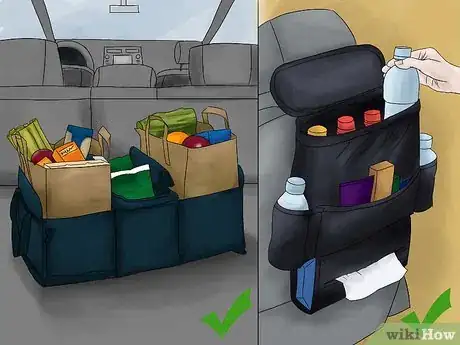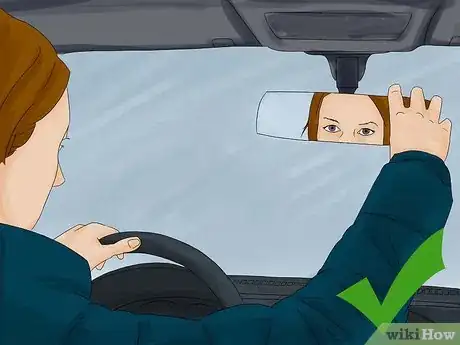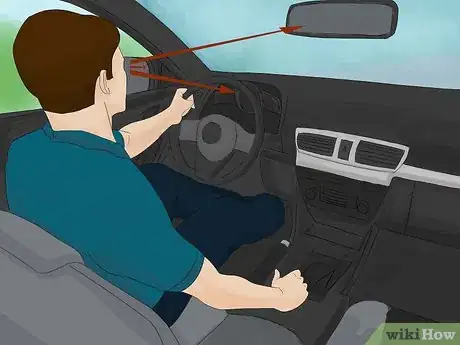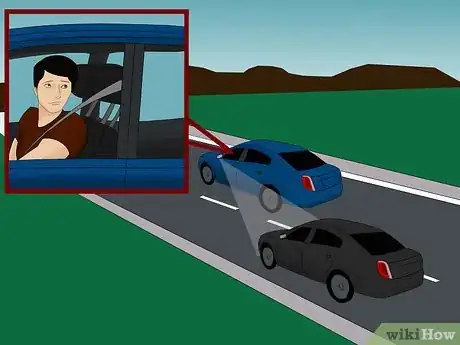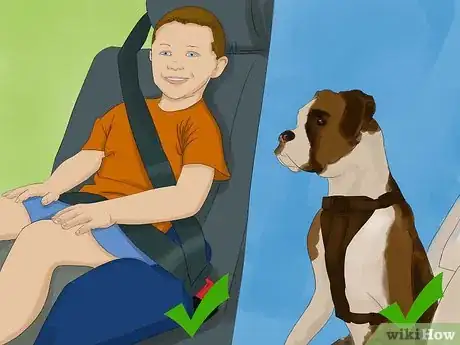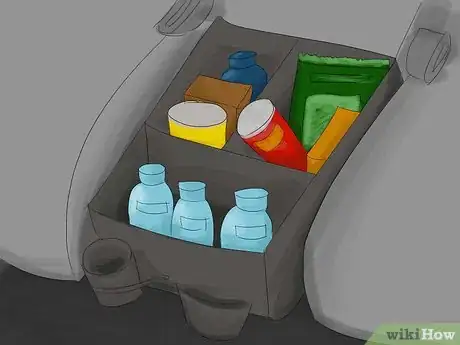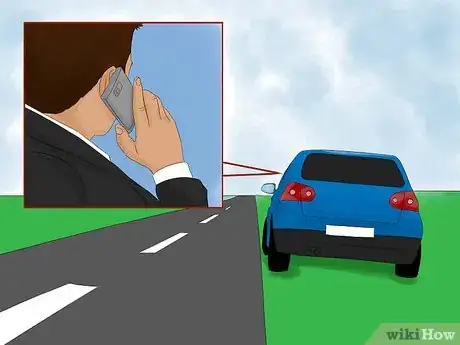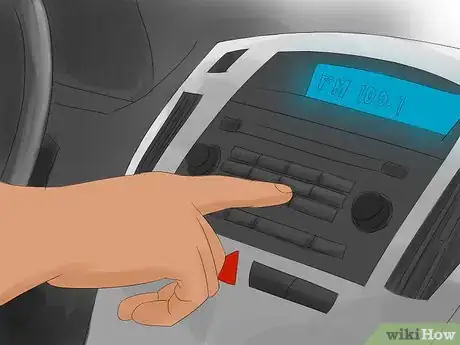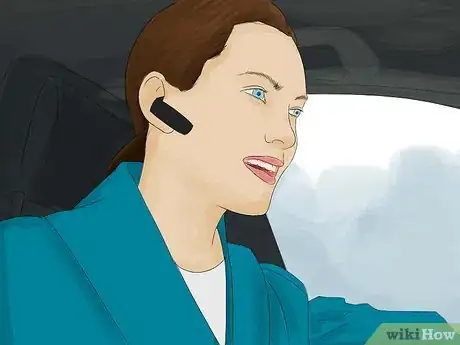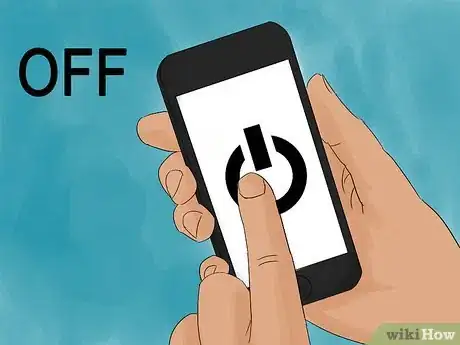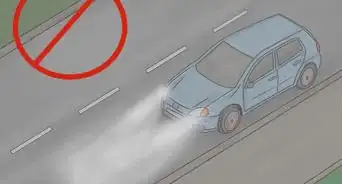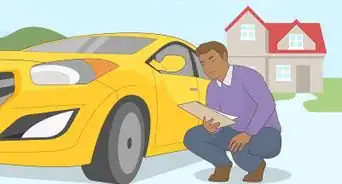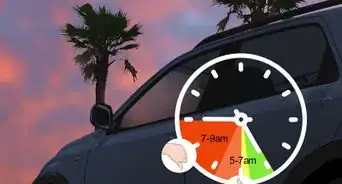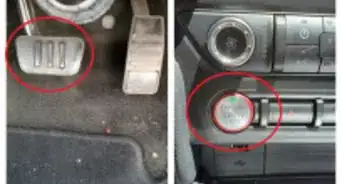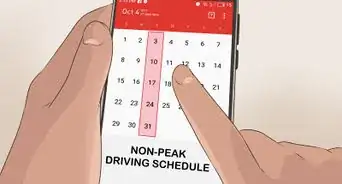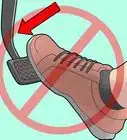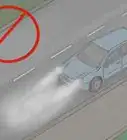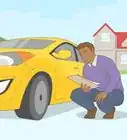This article was co-authored by Simon Miyerov. Simon Miyerov is the President and Driving Instructor for Drive Rite Academy, a driving academy based out of New York City. Simon has over 8 years of driving instruction experience. His mission is to ensure the safety of everyday drivers and continue to make New York a safer and efficient driving environment.
There are 7 references cited in this article, which can be found at the bottom of the page.
wikiHow marks an article as reader-approved once it receives enough positive feedback. In this case, 100% of readers who voted found the article helpful, earning it our reader-approved status.
This article has been viewed 117,542 times.
Although driving is a common, everyday activity, it can be dangerous if the driver fails to pay attention to what is going on around them. It can be difficult to devote the necessary amount of attention to the road and others on it if distracted by passengers or cell phones. In order to ensure you are paying attention to what is going on around you as you drive, exercise some common methods to keep your focus on the road.
Steps
Paying Maximum Attention to the Road
-
1Stow or secure all loose items before you set off. A common source of distraction is caused by loose items rolling about the floor of the vehicle as you drive. Ensure you stow all loose items in containers such as the glovebox, the boot or the center console before you begin driving.[1]
- Ensure groceries are stowed safely in the boot of the vehicle or inside the roofbox if you have one, before driving home.
- Make sure anything you keep in the cabin of your car is secure and won’t roll about as you drive.
-
2Finish dressing and grooming at home. Some drivers use their daily commute before work as an opportunity to complete their grooming regiment prior to stepping foot in the office. This can be dangerous because it takes your focus off of the road.[2]
- Make sure to finish shaving or applying make-up at your house prior to driving to work.
- Make any grooming corrections once you have pulled over or arrived at your workplace.
Advertisement -
3Give yourself extra time to get there. Try your best to leave early so you're not rushed getting to your destination. That can help prevent you from making a mistake that could cause an accident.[3]
- If you're usually late to work, for instance, you might try waking up a little earlier in the morning. If you're rushing to get to appointments after work, try scheduling them 15 minutes later so you don't have to hurry as much.
- If you're not sure where you're going, try planning out the route before you actually leave. That can help a lot, because then you don't have to look at your navigation, try to figure out where you are, and deal with other drivers.[4]
-
4Adjust your mirrors before you set out. If you share your vehicle with someone else, you may find the driver's seat and/or the mirrors on your vehicle are not set properly for your needs when you get into the vehicle. Make sure to look at and adjust your mirrors prior to driving off.[5]
- Adjusting your mirrors as you drive can lead to you losing control of the vehicle and being involved in an accident.
- Ensure you have full visibility of your mirrors before setting out on any trip.
-
5Check your mirrors frequently. As you drive, you should get into a habit of checking your mirrors periodically. This will ensure you have an understanding of everything that is going on around your vehicle and help ensure you aren’t taken by surprise by pedestrians or other drivers. Checking your mirrors approximately every thirteen seconds is what is expected in the UK. However, varying on your whereabouts, you may need to check them more often than this. Be cautious.[6]
- Get into the habit of checking each mirror and your speedometer at regular intervals as you drive.
- Always check your mirrors before turning or changing lanes.
-
6Pay close attention to drivers around you. Keep track of all other vehicles around you on the road. Whether you’re on a highway with multiple lanes of traffic heading in the same direction or on a residential road with a single lane going each way, keep track of the vehicles around to make sure you don’t lose them in a blind spot.[7]
- You can lose track of vehicles in your mirrors, but if you’ve been paying attention you should still know where they are.
-
7Look for upcoming risks or obstacles. As you pay close attention to the road around you and other vehicles, you can start to anticipate possible risks or dangerous situations before they present themselves. Try to identify risky situations and act to avoid them before they happen.[8]
- Look for people or animals on the side of the road, and give them plenty of room. Do not toot your horn at horses; as this will scare them and could lead to the equestrian getting hurt, or even killed. Be tolerant and be prepared to switch off your engine to allow livestock to pass if need be.
- Keep track of things going on around you so you can anticipate risky situations before they occur.
- Be especially mindful if the weather turns rainy. When the roads are wet, drive slower, but still drive with the flow of traffic. In addition, make sure you leave plenty of space between you and the car in front of you so you don't rear-end them.[9]
Avoiding Distractions Caused by Passengers
-
1Avoid stressful or emotional conversations while driving. Even if you are looking directly at the road as you drive, you can become mentally distracted, which will prevent you from reacting to obstacles that appear in front of you as you drive. If a passenger brings up a subject you feel strongly about, wait until you've parked the vehicle to discuss the topic.[10]
- Difficult conversations can distract the driver from things that occur on the road.
- It can be difficult to pay attention when experiencing strong emotions.
-
2Make sure children and pets are secure. Before setting off on a journey of any length, make sure children are safely strapped and secured in car seats and any animals in the vehicle are safely placed where they cannot interfere with or distract your driving. If your dog is restless, put it inside the boot and have a barrier installed between the back seat and the boot ao that it cannot jump over. For extra security, put in in a cage; but ensure it has access to drinking water and gets to stretch it's legs once you stop the car. Have a rest break if embarking on a long journey, and take the dog a walk aswell.[11]
- Small dogs and similar-sized pets should be kept off of the driver’s lap while driving to avoid distractions. Cage them so they don't jump around.
- Make sure all children are wearing their seat belts and unable to move freely within the vehicle to cause distractions.
-
3Keep snacks or toys where your passengers can access them. Children will often fuss if they do not have access to their usual snacks or toys during a car journey. If you have a passenger that may create a distraction, make sure they have everything they need prior to setting off on a trip.
- Keep snacks or toys within the reach of children so they don’t attempt to unbuckle their seat belts or leave car seats. If your vehicle is fitted with a child lock, use it so that the children can't open it from the inside.
- Reaching around the car to get snacks or pass things to a child can be extremely dangerous while driving. If there are several passengers, you can ensure that another passenger will cater to the needs of the children (eg. snacks, toys, cleaning up) so as to take the worry off the driver.
-
4Ask passengers to respect that you’re driving. If you are driving with other people in the vehicle, ask that they respect the fact that you would like to drive without distraction. This means passengers should remain in their seats, not move around the vehicle, not play loud music, and not try to gain your attention while you’re driving.[12]
- Passengers should not attempt to distract you or gain your attention while driving; unless it is an emergency.
- Passengers should remain buckled up and seated while you drive.
-
5Pull over when you can’t avoid a distraction. If something comes up that is unavoidable, such as an important telephone call or a discussion that requires the driver’s full attention, simply pull over to avoid allowing the distraction to become dangerous.[13]
- Pulling over on the side of the road to take phone calls or engage in discussions is safer than doing so as you drive. Using a mobile phone behind the wheel is illegal in many jurisdictions/countries. You can get a hefty fine and/or a driving ban as a result of being caught. Use a hands-free kit or switch your phone off before driving to be extra safe.
- On many highways, there are rest stops specifically for the sake of phone calls or other things a driver may need to do whilst on the road.
EXPERT TIPSaul Jaeger is a Police Officer and Captain of the Mountain View, California Police Department (MVPD). Saul has over 17 years of experience as a patrol officer, field training officer, traffic officer, detective, hostage negotiator, and as the traffic unit’s sergeant and Public Information Officer for the MVPD. At the MVPD, in addition to commanding the Field Operations Division, Saul has also led the Communications Center (dispatch) and the Crisis Negotiation Team. He earned an MS in Emergency Services Management from the California State University, Long Beach in 2008 and a BS in Administration of Justice from the University of Phoenix in 2006. He also earned a Corporate Innovation LEAD Certificate from the Stanford University Graduate School of Business in 2018.Police Captain, Mountain View Police Department
 Saul Jaeger, MS
Saul Jaeger, MS
Police Captain, Mountain View Police DepartmentOur Expert Agrees: Distractions play a part in most vehicle collisions. Phones are the biggest culprit, but you can also be distracted by things like eating, manipulating your radio, adjusting the environmental controls in your car, doing your hair or makeup, or disciplining your child in the back seat. If you really need to do any of those things, pull over first to keep yourself and others safe on the road.
Keeping Electronics from Distracting You
-
1Choose your music or radio station while stopped. Many people choose to listen to music or talk radio while driving, but in order to ensure you minimize distractions, don’t try to change the station or track until you are stationary.
- Making changes to what you are listening to can distract you from what’s going on in front of you.
- Changing the station while stopped will allow you to focus your attention on the road.
-
2Use caution when using voice activated systems. If you need to use your phone while driving, always utilize a hands-free device that allows you to communicate without having to control your phone with your hands, which can draw your attention from the road.[14]
- Remember to keep your focus on driving when using hands-free devices.
- Never look at your phone to connect a hands-free device while you’re driving.
-
3Turn off or stow away your cell phone. In order to ensure you are not visibly distracted, keep your cell phones, laptops and tablets safely stored within the vehicle as you drive. The best way to ensure you cannot be distracted by your cell phone while you’re driving, is simply to switch it off. While your phone is off, phone calls will be sent to voicemail and text messages/social media posts will be saved until later.
- If the phone call is important, it can wait.
Expert Q&A
-
QuestionHow can I be safe in wet weather?
 Simon MiyerovSimon Miyerov is the President and Driving Instructor for Drive Rite Academy, a driving academy based out of New York City. Simon has over 8 years of driving instruction experience. His mission is to ensure the safety of everyday drivers and continue to make New York a safer and efficient driving environment.
Simon MiyerovSimon Miyerov is the President and Driving Instructor for Drive Rite Academy, a driving academy based out of New York City. Simon has over 8 years of driving instruction experience. His mission is to ensure the safety of everyday drivers and continue to make New York a safer and efficient driving environment.
Driving Instructor Make sure you drive with the flow of traffic and try not to get to too close to any other vehicles so you don't rear-end them.
Make sure you drive with the flow of traffic and try not to get to too close to any other vehicles so you don't rear-end them. -
QuestionWhat happens if I drink alcohol while driving?
 Community AnswerYou will cause an accident and kill someone else or you will get arrested and lose your driving license.
Community AnswerYou will cause an accident and kill someone else or you will get arrested and lose your driving license. -
QuestionHow do I stay focused on traffic and keep my thoughts from wandering?
 Community AnswerStay focused on the car in front of you, because that is the most important thing. If you focus on one thing, for example the license plate, it should keep your mind from wandering. However, make sure you keep your eyes moving to detect any hazards other than the car directly in front of you (e.g. pedestrians, bicycles, turning cars).
Community AnswerStay focused on the car in front of you, because that is the most important thing. If you focus on one thing, for example the license plate, it should keep your mind from wandering. However, make sure you keep your eyes moving to detect any hazards other than the car directly in front of you (e.g. pedestrians, bicycles, turning cars).
References
- ↑ http://exchange.aaa.com/safety/distracted-driving/tips-for-preventing-distracted-driving/#.WDIxDVygYlQ
- ↑ http://exchange.aaa.com/safety/distracted-driving/tips-for-preventing-distracted-driving/#.WDIxDVygYlQ
- ↑ Simon Miyerov. Driving Instructor. Expert Interview. 4 December 2019.
- ↑ Simon Miyerov. Driving Instructor. Expert Interview. 4 December 2019.
- ↑ https://www.dmv.virginia.gov/webdoc/pdf/dmv39d.pdf
- ↑ http://teendriving.com/driving-tips/getting-started/
- ↑ http://teendriving.com/driving-tips/getting-started/
- ↑ http://teendriving.com/driving-tips/getting-started/
- ↑ Simon Miyerov. Driving Instructor. Expert Interview. 4 December 2019.
- ↑ http://www.stritch.luc.edu/depts/injprev/transprt/tran1-03.htm
- ↑ https://exchange.aaa.com/safety/distracted-driving/tips-for-preventing-distracted-driving/
- ↑ http://www.nsc.org/learn/NSC-Initiatives/Pages/distracted-driving.aspx
- ↑ https://www.dmv.virginia.gov/webdoc/pdf/dmv39d.pdf
- ↑ http://www.nsc.org/learn/NSC-Initiatives/Pages/distracted-driving.aspx
About This Article
The best way to ensure you're paying the maximum amount of attention while driving is to limit anything that could distract you from the road, such as a ringing cell phone or stressful conversation. Keep distracting electronics at bay by putting your phone somewhere you can't reach before you start driving, and ask passengers to save important discussions for when you're safely parked so you can give them your full attention. While driving, check your mirrors frequently so you can stay aware of what is happening around you, and focus on paying close attention to other drivers and any upcoming obstacles, like animals or pedestrians. For more advice, like how to deal with an unavoidable distraction, read on!
